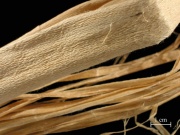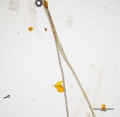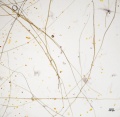Difference between revisions of "Mitsumata"
(username removed) |
|||
| (10 intermediate revisions by 3 users not shown) | |||
| Line 2: | Line 2: | ||
== Description == | == Description == | ||
| − | The [ | + | The [[bast fiber]] obtained from the bark of a shrub, ''Edgeworthia gardineri'' (formerly ''Edgeworthia papyrifera''), that is native to Asia and cultivated in Japan. Mitsumata has been used for [[paper]] since about 1600 CE. It is one of three main fiber types used for making [[Japanese paper]]. The soft, absorbent fibers produce a paper that is weaker and less absorbent that [[kozo]] due to its shorter fiber length. Mitsumata paper also tends to shrink and expand with moisture content. |
[[File:mitsumata_proc_det.jpg|thumb|Mitsumata]] | [[File:mitsumata_proc_det.jpg|thumb|Mitsumata]] | ||
| − | |||
| − | + | == Physical and Chemical Properties == | |
| − | = | + | Fiber width = 4-20 microns. Striations are fine and irregularly spaced, often crossing to form a v shape. Parenchymal cells are long with irregular surface markings. |
| − | + | Paper fiber type: non-woody/bast. Using transmitted light microscopy, fibers appear to have a broad central portion with variable ends. the lumen varies in width. Appearance with [[Graff "C" stain]]: yellowish pink. Mistumata stains lighter than [[kozo]] fibers due to a higher lignin content. Average dimensions of fibers: length 3mm, width 9μm. Common pulping method: fibers are retted, then separated mechanically. | |
== Additional Images == | == Additional Images == | ||
| Line 19: | Line 18: | ||
File:mitsumatta_50X.jpg|Mitsumata paper | File:mitsumatta_50X.jpg|Mitsumata paper | ||
File:mitsumatta_50XR.jpg|Mitsumata paper | File:mitsumatta_50XR.jpg|Mitsumata paper | ||
| + | File:Mitsumata.jpg|Mitsumata plant | ||
| + | File:Mits 40x.jpg|Mitsumata fibers stained with Graff "C" stain | ||
| + | File:Mits 10x.jpg|Mitsumata fibers stained with Graff "C" stain | ||
</gallery> | </gallery> | ||
| + | == Resources and Citations == | ||
| − | + | * T.Collings, D. Miller, 'The Identification of Oriental Paper Fibers' ''The Paper Conservator'', vol 3, 1978. | |
* Matt Roberts, Don Etherington, ''Bookbinding and the Conservation of Books: a Dictionary of Descriptive Terminology'', U.S. Government Printing Office, Washington DC, 1982 | * Matt Roberts, Don Etherington, ''Bookbinding and the Conservation of Books: a Dictionary of Descriptive Terminology'', U.S. Government Printing Office, Washington DC, 1982 | ||
| Line 29: | Line 32: | ||
* ''The Dictionary of Paper'', American Paper Institute, New York, Fourth Edition, 1980 | * ''The Dictionary of Paper'', American Paper Institute, New York, Fourth Edition, 1980 | ||
| + | |||
| + | * Marja-Sisko Ilvessalo-Pfäffli. ''Fiber Atlas: Identification of Papermaking Fibers'' (Springer Series in Wood Science). Springer, 1995. | ||
| + | |||
| + | * Walter Rantanen. "Fiber ID Course." Integrated Paper Services. June 2013. Lecture. | ||
* Bernard Toale, ''The Art of Papermaking'', Davis Publications, Portland OR, 1983 | * Bernard Toale, ''The Art of Papermaking'', Davis Publications, Portland OR, 1983 | ||
Latest revision as of 14:39, 29 October 2020
Description
The Bast fiber obtained from the bark of a shrub, Edgeworthia gardineri (formerly Edgeworthia papyrifera), that is native to Asia and cultivated in Japan. Mitsumata has been used for Paper since about 1600 CE. It is one of three main fiber types used for making Japanese paper. The soft, absorbent fibers produce a paper that is weaker and less absorbent that Kozo due to its shorter fiber length. Mitsumata paper also tends to shrink and expand with moisture content.
Physical and Chemical Properties
Fiber width = 4-20 microns. Striations are fine and irregularly spaced, often crossing to form a v shape. Parenchymal cells are long with irregular surface markings.
Paper fiber type: non-woody/bast. Using transmitted light microscopy, fibers appear to have a broad central portion with variable ends. the lumen varies in width. Appearance with Graff "C" stain: yellowish pink. Mistumata stains lighter than Kozo fibers due to a higher lignin content. Average dimensions of fibers: length 3mm, width 9μm. Common pulping method: fibers are retted, then separated mechanically.
Additional Images
Resources and Citations
- T.Collings, D. Miller, 'The Identification of Oriental Paper Fibers' The Paper Conservator, vol 3, 1978.
- Matt Roberts, Don Etherington, Bookbinding and the Conservation of Books: a Dictionary of Descriptive Terminology, U.S. Government Printing Office, Washington DC, 1982
- Book and Paper Group, Paper Conservation Catalog, AIC, 1984, 1989
- The Dictionary of Paper, American Paper Institute, New York, Fourth Edition, 1980
- Marja-Sisko Ilvessalo-Pfäffli. Fiber Atlas: Identification of Papermaking Fibers (Springer Series in Wood Science). Springer, 1995.
- Walter Rantanen. "Fiber ID Course." Integrated Paper Services. June 2013. Lecture.
- Bernard Toale, The Art of Papermaking, Davis Publications, Portland OR, 1983
- Art and Architecture Thesaurus Online, http://www.getty.edu/research/tools/vocabulary/aat/, J. Paul Getty Trust, Los Angeles, 2000







